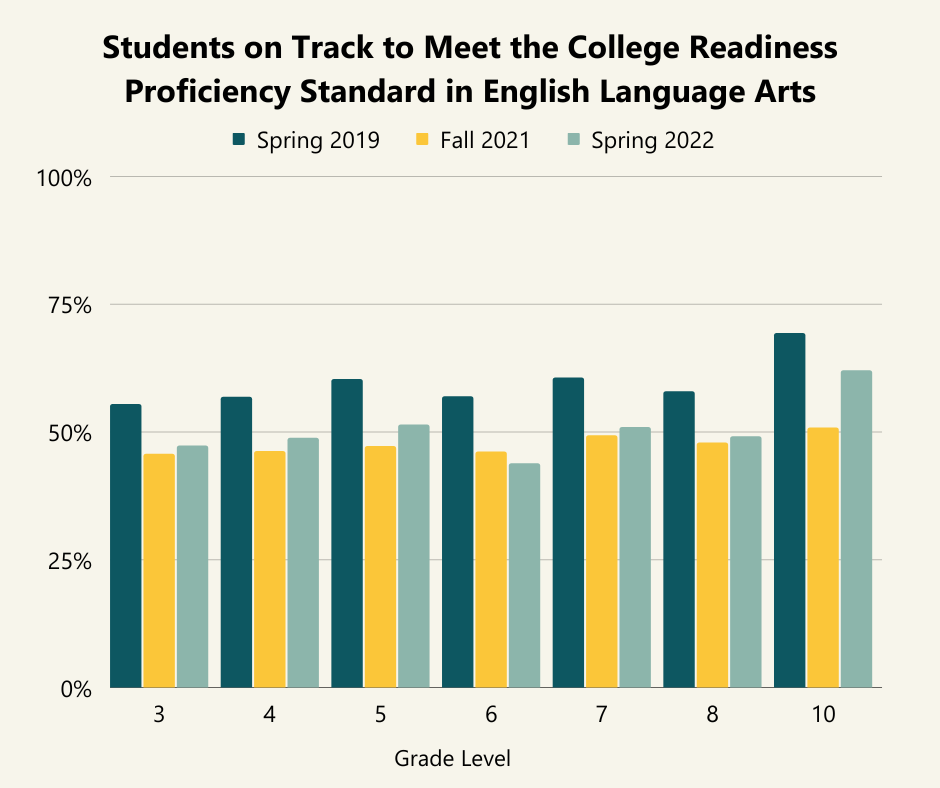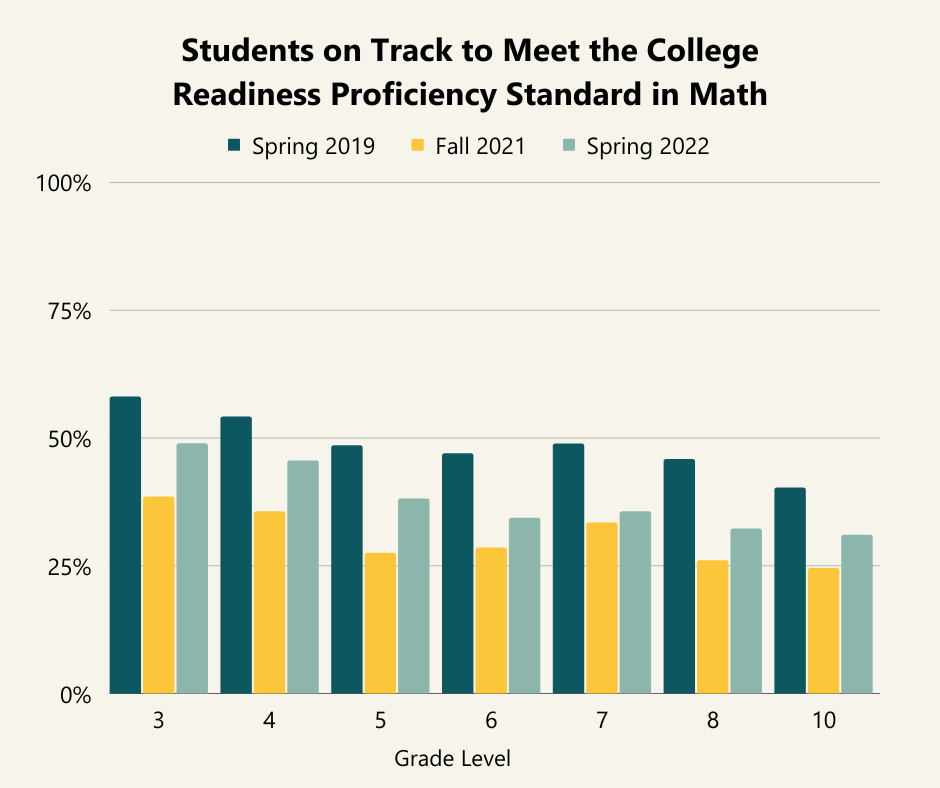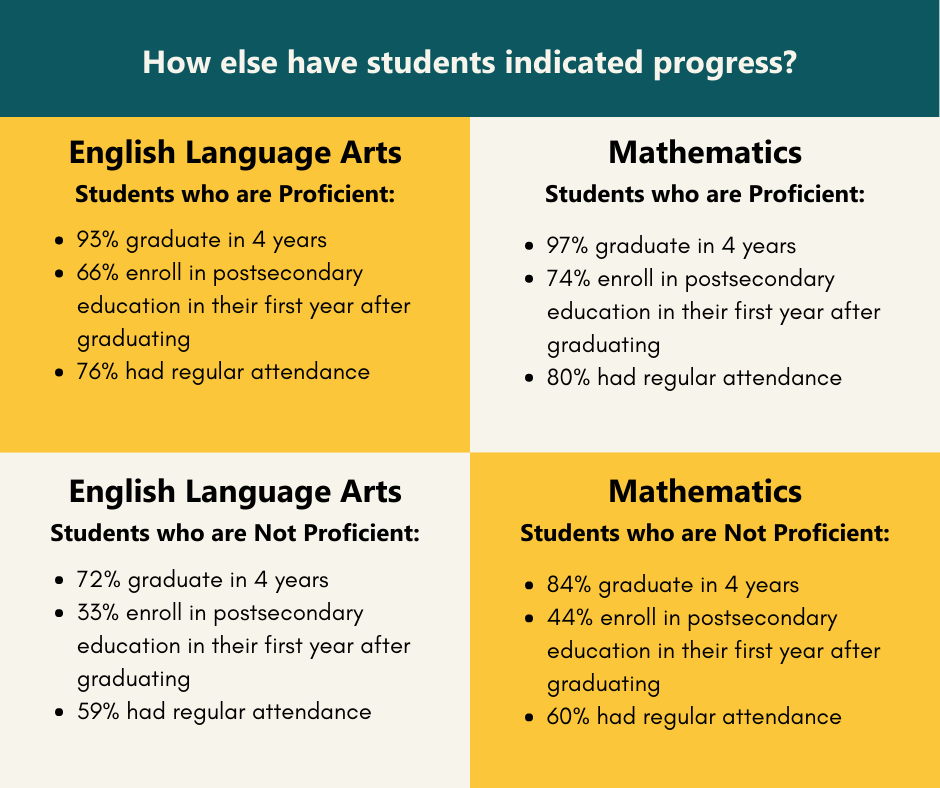|
OLYMPIA––September 9, 2022––Today, the Office of Superintendent of Public Instruction (OSPI) will release data from the spring 2022 state assessments, the first "typical" statewide test since before the COVID-19 pandemic. The data show 70% of Washington's students were proficient or made progress from the fall 2021 assessments, providing a promising first look at pandemic recovery and acceleration.
The state tests, which are one of many indicators of student learning, are intended to gauge a student's performance relative to grade-level learning goals in math, English language arts, and science. On a broad scale, test scores can influence investments and policy priorities to support student learning. At an individual level, scores from the Smarter Balanced Assessment (SBA) are designed to indicate whether a student is on track for college-level learning without needing remedial classes.
Families, policymakers, and community members should be cautious about viewing state assessment scores as the primary indicator of student learning and growth. Engagement, attendance, grades, and classroom-based assignments and tests all provide important and timely information about individual students' progress to their families and educators.
 Note: Fall 2021 tests were not typical in their timing and length but give an indication of student learning and progress. Data on students who made progress on state assessments from fall 2021 to spring 2022 are available at the state level only.
Last spring, Washington students were tested in math and English language arts in grades 3, 4, 5, 6, 7, 8, and 10; and in science in grades 5, 8, and 11. The two figures below include data from the SBA, as well as from the Washington Access to Instruction and Measurement (WA-AIM) alternate assessments for students in grades 3–10 with significant cognitive disabilities.


"These data are encouraging," said Superintendent of Public Instruction Chris Reykdal. "There is no question that COVID-19 significantly impacted the learning environment. The disruptions of remote learning, quarantine and isolation, and transitioning back in person after periods of learning remotely are evident in the decrease in proficiency from spring 2019 to spring 2022. However, the incredible work of our educators and families to support students is evident in the recovery we are seeing across grade levels and subjects."
Washington students perform similar to or better than students across the nation on the National Assessment of Educational Progress (NAEP), a representative assessment of student achievement nationwide. Nationally, NAEP data show that student scores in reading and math declined from 2020 to 2022 in all grade levels assessed, illustrating how the pandemic has impacted students across the country similarly.
While the spring 2022 scores indicate progress, opportunity gaps continue to persist. Some student groups disproportionately experienced a lack of progress from the fall 2021 test to the spring 2022 test. These groups include students who are identified as low-income, students with disabilities, and students who are multilingual/English learners; as well as students who are American Indian/Alaskan Native, Black/African American, Hispanic/Latino, and Native Hawaiian/Other Pacific Islander.
Throughout the pandemic, the federal and state governments have invested significant resources to support student and staff health and safety, ensuring uninterrupted student learning, as well as ongoing student learning and well-being recovery and acceleration. At the federal, state, and local levels, supporting students furthest from educational justice and students most impacted by the pandemic has remained a priority.
In Washington, school districts have leveraged their share of these funds to provide students with tutoring, afterschool and summer learning opportunities, reengagement supports, mentoring and coaching, access to educational technology, mental health supports, and more.
OSPI has invested in reengaging students who disengaged from school during the pandemic, supporting early literacy, supporting learning recovery through alternative learning models, as well as growing the teacher pipeline and supporting new educators, among other investments.
In addition, the state Legislature has increased staffing in schools to support students' mental and physical health, including school counselors, nurses, psychologists, social workers, and family engagement coordinators. Funding for these additional support staff will be phased-in over the next three years.
It is important to remember that proficiency standards on state assessments are intended to indicate whether a student is on track for college-level learning without needing remedial classes, and these data are just one indicator of a student’s learning and growth.
 Note: Graduation and postsecondary enrollment statistics are from the Class of 2019. Attendance statistics are from all students tested in spring 2022.
Viewing Assessment Results
Assessment results for math, English language arts, and science will be posted by the end of the day today and will be available for the state as well as by school and school district on the Washington State Report Card. Users will also be able to download data files from the Report Card if they are interested in more detail.
Parents and families should contact their child's school or school district for more information about their student's assessment results.
|